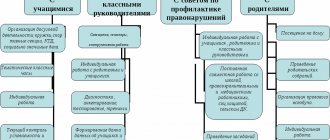Despite the fact that society has established certain boundaries and rules of behavior, it is human nature to violate them. Everyone has their own unique way of thinking, which leaves an imprint on communication with others. Sometimes this becomes the cause of such a phenomenon as deviant behavior. Examples of such non-standard thinking are quite numerous, and, fortunately, not always negative.
Definition of the concept
Deviation from generally accepted social norms is defined as deviant behavior. There are quite numerous examples of this phenomenon. At the same time, specialists from various fields define deviant behavior in their own way:
- From a sociological point of view, we can say that this is a phenomenon that poses a real threat to human survival in society. In this case, we are talking about both the deviant himself and his environment. In addition, there is a disruption in the processes of assimilation of information, reproduction of generally accepted values, as well as self-development and self-realization.
- From a medical point of view, disruption of interpersonal interactions and behavioral deviations are caused by the presence of neuropsychic pathologies of varying severity.
- From a psychological point of view, deviant behavior is an antisocial way of resolving conflict situations. At the same time, there is a desire to harm one’s own and public well-being.
Signs and criteria
The main criterion of deviant behavior is statistical. It allows you to accurately understand which behavior is deviant and which remains within the norm. Since the boundaries of norm and deviance are blurred, it is important to rely on comprehensive research.
The criteria for a norm and, accordingly, a non-norm can be determined by calculating the frequency of occurrence of a particular phenomenon in society. Anything that is widespread in society is considered the norm (the phenomenon should occur in 50% of cases).
Also important is the criterion associated with assessing an individual’s behavior. The more dangerous the behavior is for society, the more deviant it is.
In many sciences there are separate criteria for propensity to deviance , such as:
- individual psychological (denotes the degree of individuality of a person);
- psychopathological (used in medical research);
- social-normative (criteria of the norm according to society).
One of the key indicators of the norm accepted in society is the degree of adaptation of an individual person in society.
Signs of deviant behavior:
- the behavior of an individual does not correspond to the norm criteria accepted in a given society;
- an individual who commits deviant actions is perceived negatively by people around him;
- the individual causes various kinds of harm to the people around him or to himself;
- the deviant seeks to repeat his actions repeatedly and over a long period of time;
- behavior is fully consistent with the personal orientation of the individual;
- behavior is within medical standards;
- the deviant is partially or almost completely deprived of the ability to adapt to society.
Examples of deviance from life:
- Cannibalism is a highly condemned form of deviance in most countries of the world, and cannibals are prosecuted by law.
Moreover, in some remote African settlements, cannibalism is the norm, and, naturally, representatives of these tribes do not consider this deviance.The most famous cannibals are Robert Maudsley, Nikolai Dzhurmongaliev, Sergei Gavrilov.
- A striking example of deviance is the activities of the punk group Pussy Riot: dancing in church, accusing the country's ruling officials, open speeches in public places.
Main reasons
Unfortunately, psychologists still cannot accurately determine the range of reasons that provoke deviant behavior. The examples provide only a rough list. It looks like this:
- inconsistency between the goals set and the available means that can be used to achieve them;
- a decrease in the level of society's expectations from a particular individual, which gradually leads to marginalization;
- addiction to alcohol and drugs, deterioration of the genetic fund and other social pathologies;
- mental illnesses of various types;
- lack of clear motivation that would allow one to accurately determine adequate actions for a specific situation;
- social inequality and injustice that encourage aggression;
- armed conflicts, man-made disasters and natural disasters that disrupt the human psyche.
Characteristics of a deviant
Increasingly, in society one can encounter such a phenomenon as deviant behavior. Examples allow us to highlight a number of common features that are common to all people with this problem. Thus, deviants can be characterized as follows:
- cause a sharp negative reaction and condemnation from society;
- may cause physical or material harm to themselves or others;
- abnormal behavior is constantly repeated or has a permanent character;
- there is social maladjustment;
- behavioral deviations are fully consistent with individual personality characteristics;
- there is a desire to express one’s personal characteristics.
Social control as a mechanism for regulating deviations
Social control is a set of formal and informal measures aimed at preventing deviant behavior of an individual. This is a set of some means by which society or its individual group guarantees the normal behavior of its members.
Note 2
Sanctions of society or groups of people can be formally positive and negative. Positive measures include measures that stimulate the individual to behave positively.
Such measures include the assignment of various titles, awards, bonuses, and career advancement. Formally, negative measures can be considered the imposition of fines, dismissal from work, arrest, and others. Sanctions can also be informal: public reward (praise), punishment (disapproval of the team, threat). There is also such a phenomenon as a revaluation of existing norms, that is, actions that were previously considered deviant become acceptable for society.
Examples of deviant behavior in society
Despite the fact that theoretical definitions clearly describe behavioral signs, they do not always fully reflect the essence of the phenomenon. However, if you look around, you will be surprised how often deviant behavior occurs in society. Real life examples are as follows:
- People without a fixed place of residence. Due to the prevailing circumstances, their behavior differs significantly from generally accepted norms.
- Begging may cause pity or negative reactions from others. In any case, in a society where the vast majority provides themselves with material resources through work, such behavior is perceived inadequately.
- Prostitutes are morally reprehensible.
- Drug addicts and alcoholics are recognized as deviants not only because of their dependence on the use of certain substances. When intoxicated, they can pose a real physical threat to others.
- Oddly enough, monks, from the point of view of society, are also considered deviants. Most people do not understand the desire to give up all public benefits and opportunities.
- Geniuses are also treated with caution, despite the fact that scientific and technological progress has firmly entered modern life. Nevertheless, the attitude towards people with a high level of intelligence cannot be called negative.
- Murderers, maniacs and other criminals are condemned not only by society. The legislation provides for severe punishment for them.
When considering deviant behavior, examples from life can be given for a very long time. So, for example, someone might include here people of art, parasites, informal people, and so on. In any case, if desired, a person can rid himself of such a characteristic (regardless of whether it is acquired or congenital).
Prevention
Early age-related prevention of deviant behavior will help to effectively increase personal control over negative manifestations.
It is necessary to clearly understand that children already have signs indicating the onset of deviation:
- manifestations of outbursts of anger that are unusual for the child’s age (frequent and poorly controlled);
- using intentional behavior to annoy an adult;
- active refusals to comply with the demands of adults, violation of the rules established by them;
- frequent confrontation with adults in the form of arguments;
- manifestation of anger and vindictiveness;
- the child often becomes the instigator of a fight;
- deliberate destruction of someone else's property (objects);
- causing harm to other people using dangerous objects (weapons).
A number of preventive measures implemented at all levels of society (national, regulatory, medical, sanitary, pedagogical, socio-psychological) have a positive effect on overcoming the prevalence of deviant behavior:
- Formation of a favorable social environment. With the help of social factors, an individual’s undesirable behavior with possible deviation is influenced - a negative background is created regarding any manifestations of deviant behavior.
- Information factors. Specially organized work to provide maximum information about deviations in order to activate the cognitive processes of each individual (conversations, lectures, creation of videos, blogs, etc.).
- Social skills training. It is carried out with the aim of improving adaptability to society: social deviation is prevented through training work to build resistance to abnormal social influence on the individual, increase self-confidence, and develop self-realization skills.
- Initiation of activities opposite to deviant behavior. Such forms of activity can be:
- testing oneself “for strength” (risky sports, mountain climbing),
- learning new things (travel, mastering complex professions),
- confidential communication (helping those who have “stumbled”),
- creation.
- Activation of personal resources. Personal development, starting from childhood and adolescence: involvement in sports, personal growth groups, self-actualization and self-expression. An individual learns to be himself, to be able to defend his opinions and principles within the framework of generally accepted moral norms.
Only with the adequate formation of a person as a personality, an understanding of deviant behavior as an unacceptable and unacceptable form of interaction between the individual and society is created in his consciousness.
Video:
Examples of positive deviant behavior
Positive deviant behavior is actions aimed at changing outdated values and norms that hinder further social development. It can manifest itself in creativity, political activity, or simply personal protest. Despite the fact that at the initial stage society may have a negative attitude towards such phenomena, examples of positive deviant behavior prove the effectiveness of this model:
- G. Perelman is a brilliant mathematician who became famous for proving the Poincaré theorem (other scientists worked on this for more than 100 years). As a result, he was nominated for several prestigious awards. But Perelman categorically refused all awards, which is bad form in scientific circles. However, this behavior did not bring any harm to society. In addition, Perelman considered it unnecessary to belittle the contributions of other mathematicians and generally transfer science to a commercial plane.
- The next example is also quite interesting, but there is no evidence of its veracity. Thus, the original method of psychiatrist D. Rogers was recognized as a mockery of patients, for which he was sentenced to death. The idea was to bring the patient to an extreme form of hysteria, after which he would recover and continue to live a normal life. Only 50 years after the execution, the doctor’s deviant behavior was recognized as effective.
- Some examples of positive deviant behavior have had a significant impact on our lives today. So, in the late 60s, computers were the size of a living room or even a school gym. A real revolution in this area was made by Steve Jobs and Bill Gates. What many considered madness, they brought to life. Today, almost everyone has a compact and functional computer.
Classification
The typology of deviant behavior created by V. D. Mendelevich is actively used within Russian psychology and psychiatry and includes the following types:
- Delinquent. This type includes behavior that is defined by society as criminal: robbery, various types of violence, murder, and so on.
- Addictive. A person with addictive behavior seeks to distance himself from the reality around him, for which he usually resorts to the use of various psychostimulants - drugs, alcoholic beverages, puts himself into a state of trance, and actively masturbates.
Addictiveness also manifests itself in the form of various addictions (gambling addiction, shopaholia, and others). - Psychopathological. Behavior is associated with the presence of symptoms of mental disorders in a person.
- Pathocharacterological. Deviation is directly related to the personal characteristics of individual people, such as character accentuations and personality disorders.
- Hyperpowers. Geniuses and simply gifted people exhibit deviant behavior in everyday life, because they are often not adapted to it and are too immersed in what is important to them. It is also difficult for them to adapt to society.
Deviant behavior is usually divided into:
- Negative. These types of deviance negatively affect society and pose a threat to it. These are alcohol and drug addiction, prostitution, criminal activity and so on.
- Positive. Accordingly, these types of deviance benefit society and help it develop. This is super intelligence, creativity, the desire to make discoveries, explore something, and so on.
Robert Merton, a famous American sociologist of the 20th century, put forward his own typology of deviant behavior, based on the idea that deviance is a gap between goals and methods approved by society to achieve them.
Its typology includes such types as:
- Innovation. The deviant pursues goals that society approves of, but achieves them using methods that are condemned by society.
- Ritualism. The deviant denies socially approved goals and excessively exaggerates the importance of methods for achieving them. For example, a person carefully draws up documentation and demands this from his subordinates, double-checks it several times and makes a lot of copies, but the purpose of this eludes him.
- Retreatism. It intersects with addictiveness in Mendelevich’s typology: the deviant seeks to escape from reality and distances himself from both goals and methods.
- Riot. The deviant distances himself from methods and goals and sets new ones, radically different from those that society approves.
In short, Robert Merton believes that the only type of behavior that has nothing to do with deviance is the conformist type, that is, the behavior of opportunists , those who strive to fully follow the rules of society and support anything if it is approved by the masses.
A form of deviation that requires strict prohibitive and repressive measures is crime .
Examples of situations of deviant behavior
Without even thinking about it, every day we encounter situations of deviant behavior. An example might be:
- A physically healthy young man enters public transport and takes an empty seat. There is nothing wrong with this, but at the next stop an elderly man gets on. Not wanting to give up his seat, the young man begins to pretend that he is sleeping and does not notice the old man. In most cases, this deviation is due not only to personal qualities, but also to improper upbringing.
- The student constantly violates discipline in the classroom, disturbing the teacher and his peers. Unfortunately, such manifestations of deviant behavior often cause a sharp reaction from teachers, which generates even greater resistance. As a rule, indiscipline among schoolchildren is a direct reflection of the psycho-emotional state and problems in the family.
- Social inequality and financial difficulties, in theory, should encourage people to take active action to overcome this situation. However, not everyone has the willpower to do this. Some people start using alcohol or drugs to escape reality, which inevitably causes social condemnation.
- People strive for the benefits of life, but the ways of obtaining them are different for everyone. For example, many, not feeling the desire or strength to earn money on their own, resort to theft.
Literary examples
If you are interested in examples of deviant behavior, you can learn a lot of interesting things from the literature. Here are the most striking of them:
- Raskolnikov from Dostoevsky’s “Crime and Punishment” demonstrates an example of deviant behavior. For the sake of material gain, he decides to kill.
- Chatsky’s behavior in the play “Woe from Wit” by Griboyedov. This character is sometimes hot-tempered and completely tactless. He acts as an exposer of other people's vices, as well as a strict judge of moral principles.
- In Tolstoy's novel Anna Karenina, the main character can also be cited as an example of deviant behavior. Adultery, extramarital affairs, and suicide are the clearest signs.
- In Makarenko’s “Pedagogical Poem,” almost all the orphanage students in one way or another personify deviant behavior. This work is interesting primarily because the talented teacher managed to correct the situation.
- The hero of Balzac's "Gobsek" is a rather interesting example of deviant behavior. A greedy moneylender has a pathological tendency to accumulate. As a result, in his closet they find a huge amount of material assets, as well as food that has simply spoiled.
Examples from history
If you are interested in such a question as examples of deviant behavior, you can find quite a lot of interesting situations in history:
- One of the most striking examples of deviant behavior is the arson of the Temple of Artemis by a local resident of Ephesus, Herostratus. During torture, the man had to admit that he did this to glorify his name, so that his descendants would talk about him. Herostratus was not only sentenced to death, but also forbidden to mention him. Nevertheless, the historian Theopompus considered it necessary to talk about the crime of Herostratus, and therefore his goal was achieved.
- Adolf Hitler's behavior is also considered deviant. The particular danger was that he had strong leadership qualities and had power. The sad result is known to everyone.
- Another example of deviant behavior can be seen in the 1917 revolution. Then V.I. Lenin and his comrades decided to oppose the power of the tsar. The result was the formation of a fundamentally new state.
- There is a lot of evidence about how the deviant behavior of soldiers during the Great Patriotic War contributed to victory in battles. Thus, soldiers often sacrificed themselves by throwing themselves under the tracks of tanks with grenades. In this way they paved the way for their army. This is one of many examples of deviant behavior, which as a result are called a feat.
Children's deviant behavior
Unfortunately, deviant behavior in children is not uncommon. Examples that are most common are verbal aggression (foul language, rudeness and rudeness) and physical attack (hitting, biting or pushing). This phenomenon has specific reasons, the main ones being the following:
- Genetic predisposition to aggression, which is transmitted from close relatives. It is worth paying special attention to diseases associated with hearing and vision impairment, delayed mental and physical development, and mental disorders.
- The influence of external stimuli on the child’s psyche. This may be due to a tense situation in the family, conflicts with peers, or biased attitudes on the part of teachers.
- Physiological defects (speech or physical) often cause ridicule and negativity from others, and especially from children. This causes the child to feel inferior, which becomes one of the main causes of aggression.
To prevent and correct deviant behavior in children, the following measures can be taken:
- the task of adults is to arouse in the child a keen interest in communicating with peers, as well as teachers, psychologists and other adults who can help in solving the problem;
- formation of knowledge about the culture of behavior in society and skills of live communication with others;
- assistance in developing an adequate assessment of one’s own personality, as well as training in self-control techniques that will help stop attacks of aggression;
- independent or shared reading of fiction that contains positive examples of correct social behavior;
- organizing situational games during which children will independently model ways to resolve conflicts;
- rejection of habitual censures and prohibitions in favor of constructive dialogue, which is aimed at explaining to the child why deviant behavior is unacceptable.
Diagnostic methods
When diagnosing deviance, the following methods :
- dialogue with the deviant and observation of his behavior during the conversation;
- conversation with those who surround the deviant, listening to their complaints;
- testing using various questionnaires (Eysenck test, Spielberger-Hanin scale and others);
- testing to determine which emotional experiences have been repressed by a person (Rozenswijk test, Szondi test and others).
Also, when making a diagnosis, the psychiatrist studies data about the deviant, his characteristics from work and educational places, and asks other people associated with him.
Deviant behavior of adolescents
A pressing problem is the deviant behavior of adolescents, examples of which, unfortunately, are numerous. The first manifestations can be noticed around 12-13 years of age. This is the most dangerous age, when a child still has a child’s perception of the world, but at the same time there is an irresistible desire to show himself to adults. Even if children behave normally, it is extremely important not to miss this period. An alarming signal may be a change in preferences in music and clothing, as well as the first manifestations of rudeness. If educational measures are not taken in time, this can lead to the following consequences:
- running away from home and vagrancy;
- smoking, as well as alcohol and drug use;
- theft;
- association with “bad” companies;
- criminal activity;
- passion for extremist ideas;
- computer addiction;
- early sexual life;
- life-threatening hobbies.
There are known examples of negative and positive deviant behavior of adolescents. If everything is clear with the first, then many perceive the second as a normal manifestation. This may be about excessive effort in learning or physical development. Despite the fact that these actions have a positive connotation, it is important to ensure that the child does not withdraw into himself, so that hobbies do not replace communication with peers.










